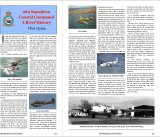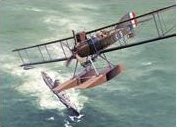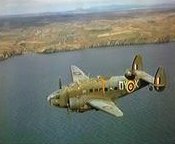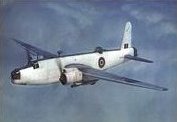 The 104th Growler
The 104th Growler
Here is an excerpt from the 104th Growler - Spring 2014.
269 Squadron Coastal Command
A brief history by Phil Styles
In the four decades from the formation of 269 Sqn to its disbandment it requires mental agility to realise that the military aviation world had gone from stick-and-string biplanes to Intercontinental Ballistic Missiles. At the time it was disbanded in 1958 the squadron was flying the Avro Shackleton.
But it requires perhaps even more mental agility to realise that in the next four decades after 269 Sqn disappeared from the list of Coastal Command squadrons the Royal Air Force would still be flying the Avro Shackleton!
So perhaps it’s more enlightening to look at the first four decades rather than the last.

269 Sqn started life in Port Said in October 1918 flying the Short 184 sea-plane together with BE2e and the DH 9 landplanes. With the rapid rundown after the end of WW1 it had disappeared in just one year and did not reappear again until December 1936 under what was then a still-secret rearmament programme. Interestingly it was recreated out of one flight of Avro Anson 1’s of 206 Sqn. and moved from Bircham Newton to Abbotsinch (now Glasgow Intl. Airport) and then to Montrose but early in 1939 it received its first Lockheed Hudsons. This was an aircraft so advanced that RAF pilots almost had to learn to fly again.
After the squadron was transferred to RAF Wick things started to get more interesting as, among other targets, the squadron was involved in attacking the infamous German battleships Scharnhorst, Gneisenau and Admiral Hipper – ships which must have looked fairly daunting from the flight deck of a Hudson! These were not the only battleships to figure in 269 Sqn’s role of honour but at least the next one was friendly. Just as in more recent times, the ‘gap’ between Norway and Iceland was strategically critical and 269 Sqn was transferred to Iceland from where it flew patrols covering HMS Prince of Wales which was carrying Winston Churchill to the USA for negotiations with President Roosevelt. One of the important outcomes of these negotiations was that eventually Coastal Command received the Liberator - an aircraft which would play a significant part in the ultimate design of the Shackleton.
Perhaps coincidentally another event took place shortly after these patrols which may also have had a part in the US entering the war. A Hudson of the squadron, operating from Reykjavik, located a submarine which it attacked with four Depth Charges. It also notified the USS Greer, an American destroyer, of the presence of the submarine which the Greer shadowed as it was detailed to do. Whoever fired first became the subject of intense debate between the US and Germany but it was the first time a US Navy ship fired on a German vessel THREE MONTHS BEFORE AMERICA ENTERED THE WAR.
And so the pattern was set for next three years in which 269 Sqn’s targets were largely U-Boats and in which the squadron was pretty successful. However, their crews could not have foreseen what was to become a unique event in the history of the RAF. On 27 August 1941 Sqn Ldr JH Thompson and Fg Off J Coleman were the only aircrew ever to have a U-Boat surrender to them! They first attacked the submerged U-570 and forced it to surface. Their subsequent attack with machine guns was so intense that the U-Boat crew waved a white flag. Thompson and Coleman then escorted U-570 to an RN destroyer which finally completed the capture.


However after the squadron disbandment, the Cold War got hotter rather than cooler and Coastal Command was not only revitalised but was also re-equipped with the only aircraft it ever had designed specifically for Maritime Reconnaissance – the Shackleton.
Once again 269 Sqn was re-created out of another. In January 1952 it took over a number of Shackleton MR1’s from 224 Squadron at North Front Gibraltar and redeployed to Ballykelly. For the next six years it participated in the usual round of UK and NATO exercises including one with the codename Exercise Strikeback which included not only Buccaneers but also the USS Forrestal. Thus 269 Squadron was again united with the US Navy but as far as is recorded, this time they didn’t fire on the enemy.
As a maritime squadron, 269 Sqn went to the great Coastal Command in the sky for the last time in November 1958.
Post Script - it finally came full circle when it was re-incarnated for the last time in 1959 and for its ultimate four years was equipped with the Thor Intermediate Range Ballistic Missile!


